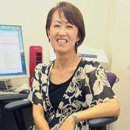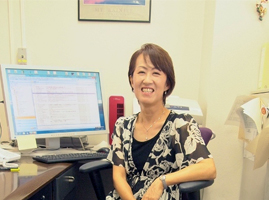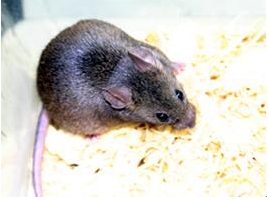SAGA, Yumiko D. Sc., Professor

- Mammalian Development Laboratory, Saga Group
Discoveries abound where people meet
Prof. Yumiko SAGA attracts people around her. She is serious when she talks about research. She turns worries into laugher. Her laboratory is always lively.
- Confidence from varied research background
- Dr. Saga says she enjoys trying many different things. She has many ideas she wants to experiment. She thinks she is special talent for finding interesting things.
 Dr. Saga has a varied research background. Upon obtaining her Ph.D., she worked as a postdoctoral researcher at Memorial Sloan-Kettering Cancer Center in New York. Returning to Japan, she worked at several research centers in different sectors: RIKEN (Institute of Physical and Chemical Research) Tsukuba Institute, Tsukuba Research Center of Banyu Pharmaceutical Co., Ltd., and the National Institute of Health Sciences of Health, Labour and Welfare Ministry before arriving at the NIG.
Dr. Saga has a varied research background. Upon obtaining her Ph.D., she worked as a postdoctoral researcher at Memorial Sloan-Kettering Cancer Center in New York. Returning to Japan, she worked at several research centers in different sectors: RIKEN (Institute of Physical and Chemical Research) Tsukuba Institute, Tsukuba Research Center of Banyu Pharmaceutical Co., Ltd., and the National Institute of Health Sciences of Health, Labour and Welfare Ministry before arriving at the NIG.- While her working environments have changed, she has maintained her cheerful disposition and moved forward with her excellent interpersonal skills. “Perhaps I’ve made a detour, but nothing has been useless.” Indeed, her experience represents immeasurable value. One of her major strengths is definitely her adaptability to change.
- Major progress from a chance discovery
- Dr. Saga’s current research theme is genetic analysis of developmental phenomena. Among various stages of development, she focuses her analysis on the mechanisms of germ cell development, somitogenesis, and cardio-vasculogenesis as three pillars of research. She first worked on germ cells when she was a corporate researcher. “Germ cells are special cells that retain pluripotency. . I wanted to find out, how their potency is generated and maintained in mice.”
- She started her research, employing the most advanced method of generating gene knockout mice to analyze functions of genes. In the early period, however, she could not get any positive results. Then one day, changes began to appear in unexpected way.
- “In the beginning, I barely noticed the strange location of expression.” She identified genes that had a specific expression just before formed somites. At that time, however, this did not interest her very much. The situation changed completely when a colleague, a specialist in somitogenesis, said that I never seen this kind of specific expression pattern. Intrigued, Dr. Saga generated the knockout mouse and found that somitogenesis was completely disrupted. As she continued her research, researchers around the world successively published reports relating to somitogenesis, as if to show their support for Dr. Saga. A project that started by chance now became a central research theme.
- “The more deeply you dig, the more questions you unearth. There’s never one simple question. This is what makes biology attractive…I’ve come to think like this.” Dr. Saga’s enthusiasm for research grows stronger year after year. She speaks of research with a delightful twinkle in her eyes, like a child full of curiosity.
- Conveying the thrill of research to the next generation
- Dr. Saga says that for her the real thrill of being a researcher is witnessing the very moment of a discovery. Once you have this experience, you plunge back into research for a second. In addition to her own research, she receives most stimulation from graduate students and postdoctoral researchers in her laboratory. “They work very seriously to find something. They proactively think and conduct experiments. I’m very happy about them. I hope they will make exciting discoveries all on their own.”
 As a researcher, she wants the students and postdoctorals in her laboratory to experience the true thrill of research. For that, she always has discussions with them to lead them to become fully aware of the significance of each experiment and steps to take. Another thing she tries to achieve through discussions with her students is to sprinkle her talks with useful ideas. “I don’t expect them to capture all of them. There’s no single best way to do things. I simply want to give hints so that they can find something that has a meaning to them.” She intends to continue this discreet, not pushy, method of encouragement.
As a researcher, she wants the students and postdoctorals in her laboratory to experience the true thrill of research. For that, she always has discussions with them to lead them to become fully aware of the significance of each experiment and steps to take. Another thing she tries to achieve through discussions with her students is to sprinkle her talks with useful ideas. “I don’t expect them to capture all of them. There’s no single best way to do things. I simply want to give hints so that they can find something that has a meaning to them.” She intends to continue this discreet, not pushy, method of encouragement.- “I want to support the students’ spontaneous enthusiasm,” she says in a firm but warm voice. She provides a place where students and postdoctoral researchers can put their potential to test to progress at their own pace.
- (Interviewed by Leave a nest Co.,Ltd in 2006)
















